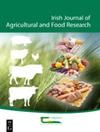Effect of nitrogen fertiliser application timing on grain yield and grain protein concentration of spring barley
IF 1.4
4区 农林科学
Q3 AGRICULTURE, MULTIDISCIPLINARY
引用次数: 2
Abstract
Abstract There is relatively little recent information regarding the effect of timing of fertiliser N application to spring barley on grain yield and grain protein concentration (GPC) under Irish conditions. The objectives of this work were to examine the effects of a) timing of the first N application to spring barley (at sowing or at crop emergence), b) altering the proportion of the total N allocation that is applied in the first of two applications and c) delaying a portion of the total N dose until after the tillering phase on grain yield and GPC of spring barley. Twenty experiments were carried out over four seasons (2011–2014) in the south and south-east of Ireland. Results indicated that there was little consistent difference, in terms of grain yield or GPC between applying the first N at sowing compared to where the initial N application was made at crop emergence. Similarly, altering the proportion of N applied in the first application, irrespective of whether the first application was at sowing or at crop emergence, had little effect on either yield or GPC. Delaying the application of a portion (0.2) of the total N until after the tillering stage also had little consistent effect on either yield or GPC. It is concluded that where the majority of N is applied to spring barley before the end of the tillering stage, altering the timing of applications or the proportion of the total applied in each application will have limited effect on grain yield or GPC.施氮时机对春大麦产量和籽粒蛋白质浓度的影响
关于爱尔兰条件下春大麦施氮时机对籽粒产量和籽粒蛋白质浓度(GPC)的影响,最近的研究相对较少。本研究的目的是研究a)春大麦第一次施氮的时机(播种时或作物出苗期),b)改变两次施氮中第一次施氮的比例,以及c)将总施氮量的一部分推迟到分蘖期之后对春大麦籽粒产量和GPC的影响。在爱尔兰南部和东南部的四个季节(2011-2014年)进行了20次实验。结果表明,在籽粒产量或GPC方面,播种时施用第一次氮肥与作物出苗期施用第一次氮肥相比几乎没有一致性差异。同样,改变第一次施氮的比例,无论第一次施氮是在播种还是在作物出苗期,对产量或GPC的影响都很小。将总氮的一部分(0.2)延迟到分蘖期后施用,对产量和GPC的影响也不大一致。综上所述,在分蘖期结束前对春大麦进行大量施氮时,改变施氮时间或每次施氮的比例对籽粒产量和GPC的影响有限。
本文章由计算机程序翻译,如有差异,请以英文原文为准。
求助全文
约1分钟内获得全文
求助全文
来源期刊
CiteScore
2.50
自引率
20.00%
发文量
23
审稿时长
>36 weeks
期刊介绍:
The Irish Journal of Agricultural and Food Research is a peer reviewed open access scientific journal published by Teagasc (Agriculture and Food Development Authority, Ireland). Manuscripts on any aspect of research of direct relevance to Irish agriculture and food production, including plant and animal sciences, food science, agri environmental science, soils, engineering, buildings, economics and sociology, will be considered for publication. The work must demonstrate novelty and relevance to the field of research. Papers published or offered for publication elsewhere will not be considered, but the publication of an abstract does not preclude the publication of the full paper in this journal.

 求助内容:
求助内容: 应助结果提醒方式:
应助结果提醒方式:


